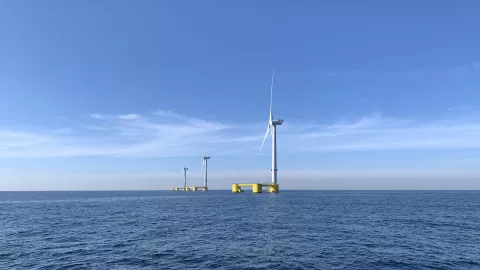In a world that is less and less dependent on fossil fuels, hydrogen (H2) has a key role to play in accelerating this change and achieving carbon neutrality. As an energy carrier or a catalyst for its production, H2 is the bridge to a greener future.
In terms of economic evolution, it is difficult to imagine a sustainable world without including hydrogen in the equation. João Nicolau, Hydrogen projects head at EDP, believes that it is impossible: ''Only with H2 will we reach this goal. Green hydrogen is produced from renewable electricity and in its use, no CO2 is emitted.'' António Vidigal, from EDP Inovação, shares this opinion and highlights the fact that there is “a set of uses that are not suitable for electrification.” Rather, he believes that ''electricity and hydrogen are convincing in their own right. But if fossil fuels are the problem, they must be taxed, in order to accelerate their discontinuation.''
In industries where hydrogen has been an essential raw material for decades, such as petrochemicals, refining and ammonia production, what remains to be done is to ensure its evolution in 'color', from gray and blue to green (know more about the colors of hydrogen, here). And it is in this aspect that the versatility of H2 stands out. ''Its production from renewable sources can replace, for example, the use of fossil fuels,'' says João Nicolau, highlighting this solution also ''in the production of industrial heat, as in the glass, ceramics or steel industries.''
In these energy-intensive sectors, Nuno Filipe, EDP NEW's project manager, also highlights aluminum, cement and ''the production of green ammonia, as will be done by Bondalti in Estarreja.''
Versatile and strategic
Its multiple uses, always efficient from an environmental point of view, are the ones that put hydrogen at the forefront in the energy sector. H2 can be used to supplement or replace natural gas in certain industries; it may turn out to be the 'fuel' of choice for means of transport in cases where electricity is not enough - heavy vehicles, railroads, aviation, maritime navigation; it can be produced using electricity to take advantage of the periods when the grid is under less demand; and it can also be used to generate electricity in periods of higher demand and lower production.
It is no coincidence that many of the most recent green hydrogen production studies are closely associated with renewable energy production sites, whether solar, wind or offshore wind. Always with a goal of balancing and monetizing energy production. Like the BEHYOND project, where EDP Inovação participates, which aims to evaluate hydrogen production in offshore wind farms. “Green hydrogen produced from renewable energy sources will become one of the main boosters of decarbonization, while mitigating the intermittent nature of renewable energy sources,” explains Sofia Ganilha, BEHYOND's project manager.

"Green hydrogen will become one of the main contributors to decarbonization, while mitigating the intermittency of renewable energy sources."
Sofia Ganilha, BEHYOND's project manager.
Even at the level of obsolete industrial infrastructures, hydrogen offers advantages in terms of efficiency. The conversion of plants that operate on coal or other fuels is always an hypothesis on the table. Avoiding the complete dismantling of an industrial unit, adapting it, is also promoting efficiency and the environment, as well as employment and the local economy, by avoiding the construction of yet another 'factory' elsewhere.
Europe invests in hydrogen
In 2020 the European Clean Hydrogen Alliance, to which EDP belongs, was launched, and the objectives of promoting H2 as a decarbonization vehicle are clear. It is a “key facilitator to achieve the goals of the European Green Deal and Europe's transition to clean energies,” reads the alliance presentation, which also highlights this solution to "decarbonize industrial processes and economic sectors where the reduction of carbon emissions is both urgent and difficult."
The goals that came out of the Paris Agreement, in 2015, are clear. It is necessary to orient the investment towards the promotion of low emission technologies, in order to guarantee that the global average temperature does not rise more than 2ºC until 2100, trying to limit this increase to 1.5ºC. And green hydrogen, with the constant evolution of technology, which is already beginning to be noticed in its production cost, fits perfectly into this global design.
EDP has been committed to global decarbonization strategies for several years, with energy transition projects, investment in innovation, and an increasing focus on renewable energies in Portugal and in several other countries. EDP recently presented a plan for the period between 2021 and 2025, which foresees an investment of 24 billion euros in the energy transition - which includes hydrogen - in order to anticipate by 20 years the carbon neutrality international goals for 2050. Hydrogen is just another step in EDP's already long way, but a safe step that led to the recent investment on a new business unit, H2BU.

"In the future, more than direct competitors, H2 and electricity will tend to complement each other, due to their distinct characteristics and applications."
João Nicolau, EDP's Hydrogen projects head
H2 as a complement to electric energy
João Nicolau thinks that H2 and electricity, more than direct competitors in the future, in certain areas “will tend to be complementary, due to their distinctive characteristics and applications.” And it is precisely in this way that we can achieve “a faster decarbonization of the economy.”
Pedro Valverde, Cleaner Energy manager at EDP Inovação, also sees hydrogen as a complement to electricity, “each with its own potential and application.” On the other hand, as a large electrical capacity is necessary for the production of hydrogen, Pedro Valverde points out that ''routes and technologies are being developed for its transport from the places where there is more renewable resources and potential for H2 production in a more competitive way, to the regions of greater consumption.'' Portugal, due to the growing weight of renewable sources and an even greater potential, is one of the countries that may become major exporters of hydrogen.

“Routes and technologies are being developed for the transport of hydrogen from the places where the renewable resource is more abundant and there is the potential for H2 production in a more competitive way.”
Pedro Valverde, Cleaner Energy manager at EDP Inovação



